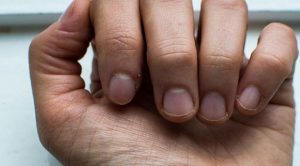
Nail Diseases: Nail is an epidermis formation on the outer surface of our fingertips and makes it easier to grasp. The nail is rectangular and outwardly convex. It is hard and translucent. It consists of 100-150 corneocytes with a thickness of 0.5¬0.7 mm. The nail grows on the nail bed. The light colored area on the nail shaped like a half moon is called “lunula”. In a healthy person, nails grow by 0.9 mm per week. The growth rates of each hand and each finger are different. It has been observed that it is prolonged rapidly in diseases such as psoriasis (psoriasis), and slowly in lichen planus (skin disease) .
Nail resembles a spoon with its concave shape. There are reasons that cause thinning of the nail. It can be seen on the toes of children and usually improves with age. The form seen in older ages is irreversible.
Many of the systemic causes , is more common local causes. It can be seen normally in early childhood.
Congenital: It may be caused by trichotiodystrophy, ectodermal dysplasia, nail patella syndrome, acromegaly, coronary disorders.
The convexity of the nail has increased considerably, the nail becomes a rotating roll within itself, often sinking into the nail bed with narrowed nail edges . Beta blocker drugs, psoriasis, tight shoes, bone tumors, subungual exocytosis, osteoarthritis, fungal infection, except for soft tissue tumors, may be genetic causes, especially in all fingers.
Recurrent infections, shoe hitting and pain are the most important complaints.
In the treatment, substances containing urea can be given to soften the nail. It can use some spring-loaded apparatus that corrects gradually. The nail can be cauterized so that it does not come out completely. Sometimes, the nail bed can be surgically corrected to ensure that the nail grows properly.
The most extreme bone of the thumb (distal phalanx) is wider and shorter than normal, so the nail bed is also very short. It is not usually related to a disease. It is an inherited condition that is more common in women.
T iRNAi fungal infections , mainly formed by organisms dermatophydid given name. It is an infection that affects the nail bed and plate. It accounts for about 50% of all nail disease.
The outer parts of the nail turn and thicken in the nail bed, coarse and hard, hence the name claw nail. It can be in the form of a horn or a beak.
This problem most commonly occurs in the big toe. It is very common in the elderly. Although the patient usually does not accept it, the inability of the patient to cut his nail is an important factor.
Circulatory disorders are more common in those with anatomical disorders such as hallux valgus and those with keratinization disorders. It may be due to chronic trauma and completely idiopathic.
These horizontal grooves in the nail represent a disruption in the growth of the nail. Its depth and width give clues about the situation. Operations, stress, allergic diseases, medications, infections such as scarlet fever, measles, typhus and sometimes diseases such as pellagra, SLE, pustular psoriasis and trauma may be the cause of these lines.
It is the separation of the tips of the nails into layers like diamond dough. It is seen in some blood diseases (polycythemia), AIDS disease and some pancreatic diseases (glucagonoma). Frequent wetting and drying of the nails also occur with nail polish, acetone, excessive cuticle and trauma.
Partially or whole nail, in the form of dots or lines, at birth or later. It can be seen due to tuberculosis, nephritis, lymphoma, frostbite injury, cancer metastases, typhoid fever, cirrhosis, leprosy, ulcerative colitis, nail biting, use of cancer drugs, hard cuticle.
It is a condition characterized by playing with the nail, biting and plucking the skin at the base of the nail. It is common due to psychological stress.
In the nail bed, they are 2¬3mm longitudinal bleeding lines as if the splinter had sunk. If it is on a single finger or very faint, it is not a typical finding.
It is most commonly seen in bacterial endocarditis (inflammation of the pericardium), in Raynould’s disease, Antiphospholipid syndrome, Collagen and vascular diseases, hypertensive patients, rheumatoid arthritis and mitral valve stenosis, hemodialysis patients and psoriasis, nail fungus, scurvy, eczema, pemphigus. .
It is usually seen at the tip, but in onychomatrixoma, a nail bed tumor, hemorrhage is seen at the bottom of the nail.
Nails are normally formed in the nail root, under the skin called the germinal matrix, and grow forward on the upper part of the finger, which we call the nail bed.
Sometimes the nail tips sink into the skin from the sides and start a reaction like a foreign body, sometimes the nail may become completely sunken into the nail bed, not just in the corners.
In both cases, the first signs are pain and swelling.
There may be bleeding in the stinging area or inflammation may develop due to infection. Putting on shoes and walking can be very difficult. If left untreated, progression of inflammation to the bone (osteomyelitis) and systemic infections may occur.
Especially in diabetic patients, such inflammation may be the reason for the loss of the finger or even the foot with late treatment.
What is Varicocele? Varicocele is the varicose veins that drain the blood in the testicles,…
What is Hemorrhoids ? It is a disease caused by the loosening of the veins…
What Is Monkeypox Virus? Symptoms and Ways of Transmission! The monkeypox virus, which has been…
What is Pelvic Venous Congestion Syndrome? (Failures Observed in Ovarian/Testicular Veins) What is Pelvic Venous…
What is Myoma ? Myoma, is a benign tumor arising from the uterine muscles. It…
What is Back Lift? Back stretching, excessive weight gain and aging may cause you to…